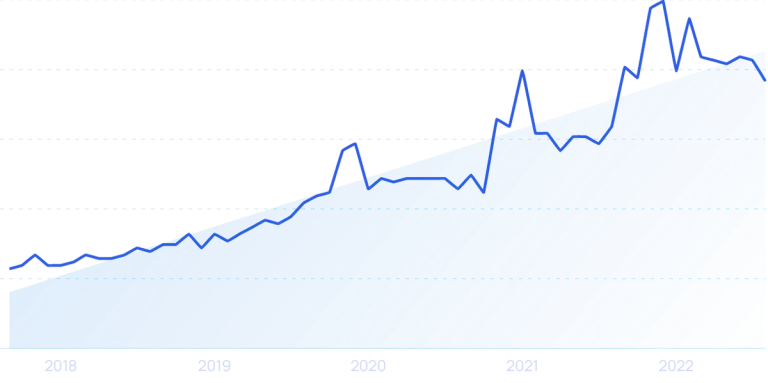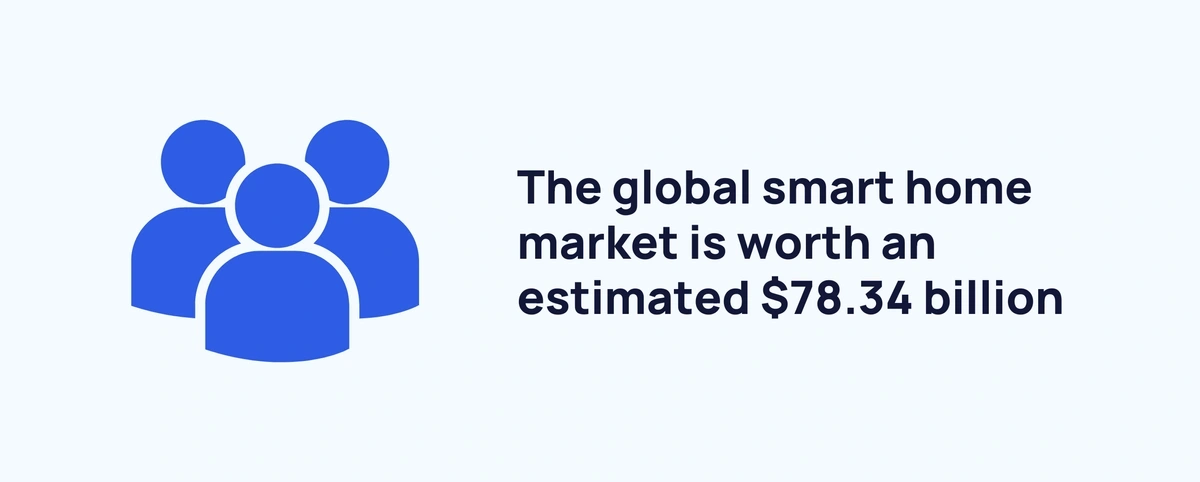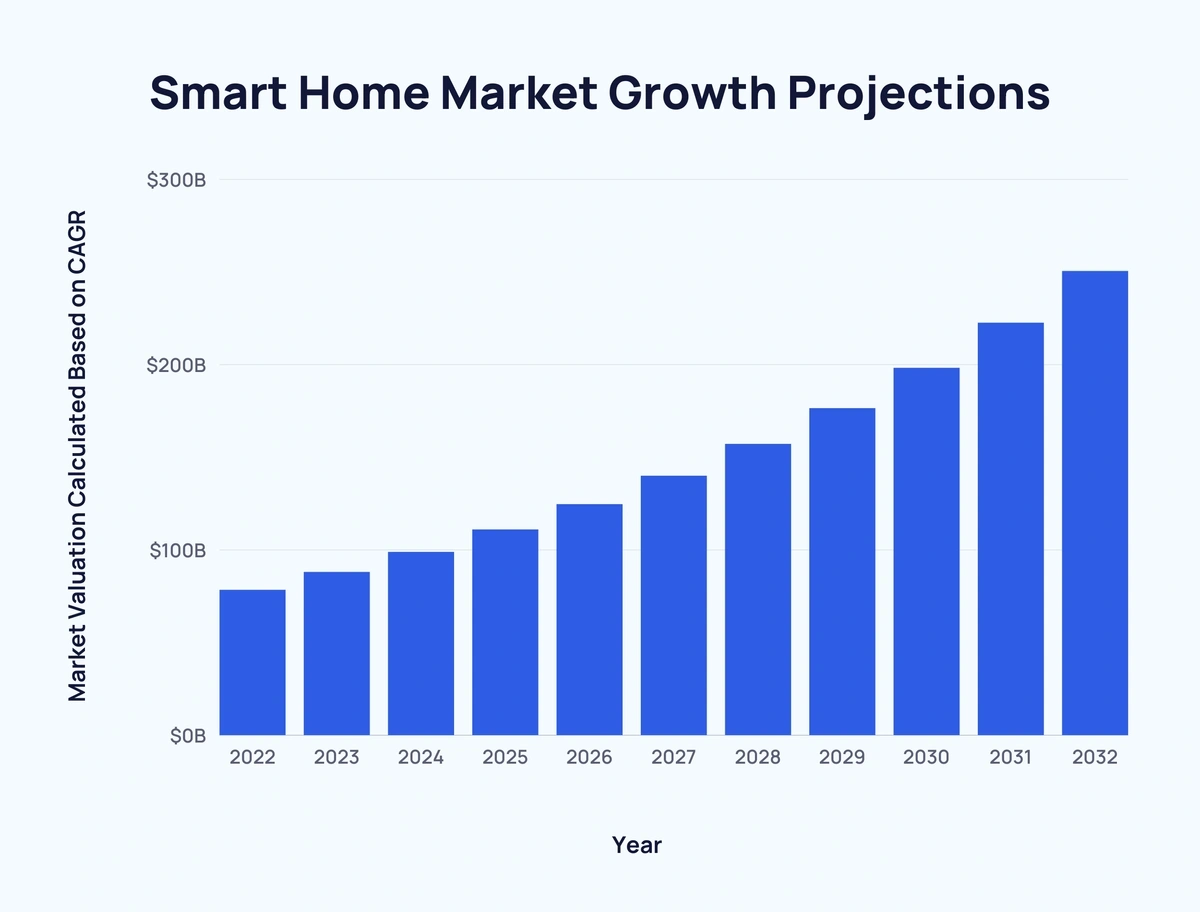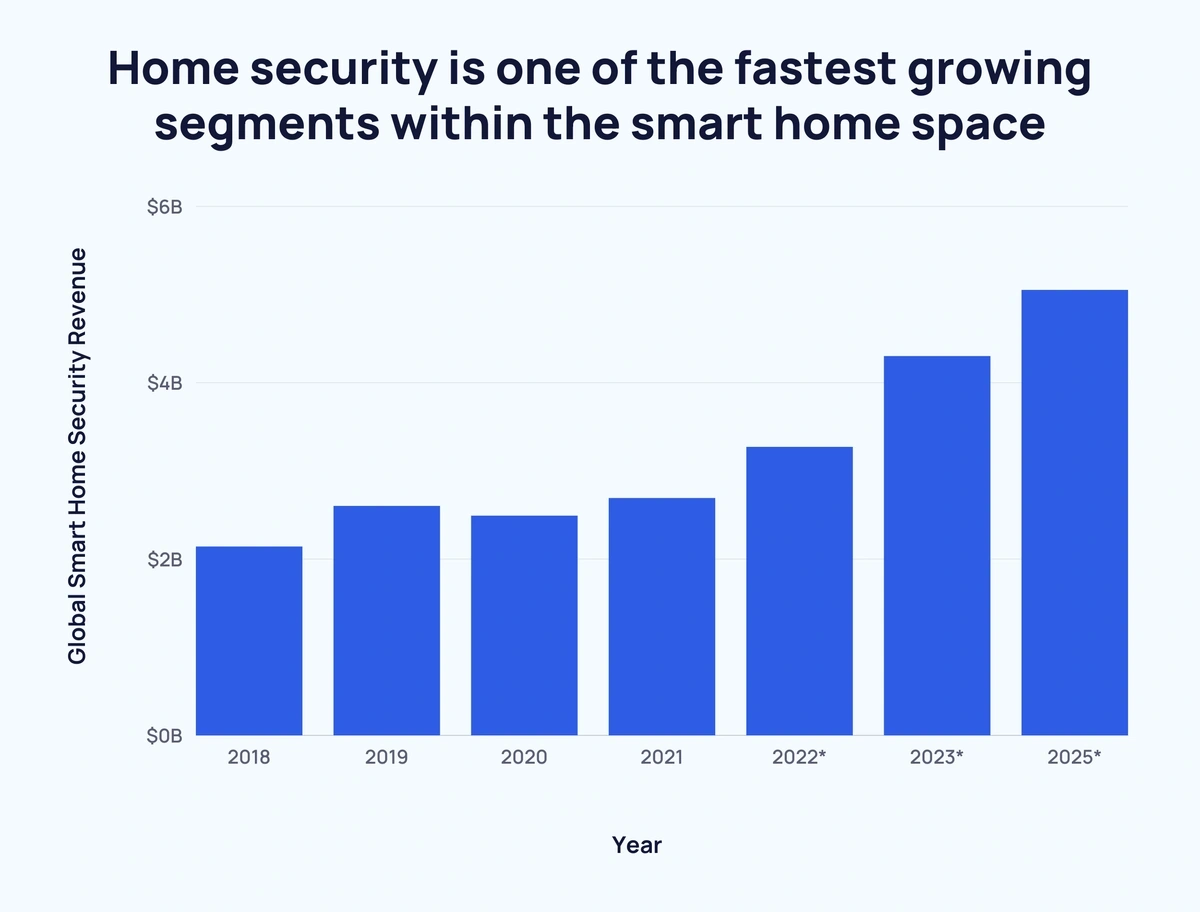Smart homes are on the rise, and the adoption of smart connected devices is growing rapidly around the world.
There are several reasons for the increased adoption, including new technology, affordability and numerous benefits for users.
Below we take a closer look at the statistics for the smart home market.
Smart Home Industry Highlights
The global smart home market is worth approximately $80 billion. By 2032, the smart home market is projected to reach $250 billion. The global smart home market is growing at a CAGR of 12.3%. By region, the Far East and China hold the largest smart home market share. The home security market share is expected to grow by 6% over the seven years.
Smart home market size
According to the latest data, the global smart home market is worth an estimated $78.34 billion.
Better technology, greater affordability, and the desire for connected homes are the key reasons behind the rapid growth of the market.
According to the data, smart home consumer spending is growing from $86 billion in 2020 to approximately $134 billion in 2022.
Additionally, market spending is expected to grow to $173 billion worldwide by 2025, nearly double the 2020 figure, according to Strategy Analytics.
Source: FutureMarketInsights, Strategy Analytics
Smart home market growth forecast
The global smart home market is expected to reach $98.8 billion by 2024.
The smart home segment is expected to reach $250.46 billion by 2032, at a compound annual growth rate (CAGR) of 12.3%.
Here is a look at how the smart home market is predicted to grow over the next decade:
Year Market Value Calculated based on CAGR 2022 $78.34 billion 2023 $87.98 billion 2024 $98.8 billion 2025 $110.95 billion 2026 $124.6 billion 2027 $139.93 billion 2028 $157.14 billion 2029 $176.46 billion 2030 $198.17 billion 2031 $222.54 billion 2032 $250.46 billion
Source: FutureMarketInsights
Growth drivers for the smart home sector
Advances in security technology are a major driving force in the smart home market.
Additionally, the rise of Internet of Things (IoT) devices has led to greater connectivity within the home, and smart devices have become more affordable in recent years, further accelerating their adoption.
Increased security, interconnectivity, customizability and lower pricing will continue to propel the market to new heights.
Source: FutureMarketInsights
Key Players in the Smart Home Market
Samsung (South Korea) Huawei (China) Qualcomm (US) Alphabet (US) LG Electronics (South Korea) Microsoft (US) Beijing Didi Technology (China) Xiaomi (China) eBay (US) Midea (China) Intel (US) ZTE (China) Gree Appliances (China) Snap (US) Alibaba (China) Amazon (US) Philips (US) Google (US) Apple (US) IKEA (Sweden) Siemens (Germany) Bosch (Germany) Belkin (US)
Source: iplytics, The Buddy Company
Geographic Breakdown of Smart Home Market
Regionally, the Far East and China currently account for the largest smart home market share, with around 521.8 million smart home units shipped in the region, nearly double that of Europe (283.1 million) and North America (250 million).
Let's take a closer look at the data:
Year Far East & China Europe North America Latin America Others 2020 140.5 million 81.2 million 75.7 million 9.5 million 42.2 million 2021* 220.9 million 119.6 million 118.6 million 14.3 million 63.7 million 2022* 289.8 million 165.6 million 151.6 million 21.3 million 89.1 million 2023* 375 million 219.6 million 192.5 million 31 million 121.8 million 2024* 521.8 million 283.1 million 250 million 45 million 175.8 million2025* 726.7 million 384.9 million 329.2 million 68.8 million 260.9 million
Source: Juniper Research
Smart Home Industry Growth by Segment
Consumer spending on smart home devices is on the rise.
Here's a more detailed look at the numbers:
Year Consumer Spending 2019 $95 billion 2020 $86 billion 2021* $123 billion 2022* $134 billion 2023* $147 billion 2024* $159 billion 2025* $173 billion
In terms of segments, video entertainment holds the largest share of the market.
However, this figure is declining.
Year Video Entertainment Home Security Smart Speakers Other 2018 48.2% 15.2% 15.5% 21.1% 2019 41.7% 19.2% 16.5% 22.5% 2020 37% 20.5% 16.3% 26.2% 2023* 29.9% 22.1% 14.3% 33.7% 2024* 31.3% 21.1% 14.1% 33.5% 2025* 27.6% 21.2% 14.4% 36.9%
Home security is one of the fastest growing segments within the smart home sector.
The numbers are as follows:
Year Global Smart Home Security Revenue 2018 $2.14 billion 2019 $2.6 billion 2020 $2.49 billion 2021 $2.69 billion 2022* $3.27 billion 2023* $4.3 billion 2025* $5.05 billion
*Estimated figures
Meanwhile, digital voice assistants are expected to double from approximately 4.2 billion in 2020 to 8.4 billion by 2024.
Source: Strategy Analytics, BRC, Juniper Research
Conclusion
The smart home market is growing rapidly in value year over year.
Additionally, increasing adoption of smart home products will help make a truly connected home a reality, further expanding the market.
For more smart home content, check out our Smart Home Stats post.





